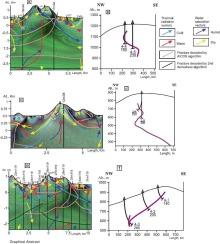Prospectivity mapping of high-purity barite mineralization in the Eastern Nigerian basement terrane using generalized algorithm-decoded thermal infrared data
IF 3.6
2区 地球科学
Q1 GEOLOGY
引用次数: 0
Abstract
The Eastern Nigerian Basement Terrane hosts significant barite deposits critical for Nigeria’s oil and gas industry, yet exploration remains limited to shallow artisanal mining that yield low-quality barite. This study presents a novel integration of Landsat-7 ETM + thermal infrared data and Shuttle Radar Topography Mission (SRTM) elevation data with the Thermal Generalization Method (TGM), a multichannel algorithm that transforms TIR-SRTM data into 3D thermodynamic models. Using algebraic-geometric transformations and algorithms including generalization (G), automatic identification of cell-block structure (AICDS), litho-temperature (LT), vertical temperature (VT), first/second Vertical Derivatives (IVD, 2VD), the method delineates high-purity barite mineralization at depths surpassing typical artisanal operations. Seasonal analysis quantified a 17 % drop in mean surface thermal radiation (10.42 to 8.67 W m−2) and a 37 % rise in mean surface water saturation (0.46 to 0.63), showing a strong negative correlation (r = –0.72) that confirms seasonal heat-fluid coupling enhances mineralization potential at depth. TGM analysis identified two potential barite fields (PBF1 and PBF2) in the Mayo-Belwa and Jada-Ganye basement terranes, representing substantial, previously unrecognized high-grade targets within Nigeria’s estimated 22 Mt barite reserves. These fields are characterized by dominant NNE-SSW lineaments and NW-SE stresses interact, with subordinate NNE-SSW stresses enhancing permeability through localized deformation, creating structural/thermochemical fluid pathways. PBF1 (Taso-Tola deposits), hosted in a deflection zone dominated by granite-gneisses, shows strong thermal anomalies (∇T > 0.5 K/m; ∂2T/∂z2 < − 0.3 K/m2), indicative of exothermic barite precipitation at temperatures of 60–80 °C. Economic mineralization occurs along ENE lineaments at 180–300 m depth (ΔT = 1.2 K, signal-to-noise ratio [SNR] 2000:1), with 70–90 % water saturation. These anomalies exceed Landsat’s thermal resolution threshold by > 3 orders of magnitude, providing a robust, deterministic confidence framework. The Taso sector shows sharp thermal boundaries (∂T/∂z > 0.6 K/m) along 540 m fractures, whereas Tola’s mineralization persists to 1,200 m (ΔT = 0.3 K, SNR 2700:1) beyond optimal mineralization depths. PBF2, hosted in syn- to post-tectonic granites within zones of intense uneven uplift, exhibits subdued thermal signatures (40–60 °C) and moderate water saturation (50–70 %). NW‒SE compression generates ENE uplift blocks controlling mineralization: Yebbe extends 610–750 m (60–300 m), Zeibei is vertically reoriented below 240 m, and Ngurore exhibits propeller geometry (870–780 m). High thermal gradients (∇T > 0.7 K) and water saturation (W > 0.3) favour barite deposition at 60–300 m depth, controlled by NNW-trending faults, although deeper anomalies (ΔT = 0.08 K at 1,800 m) lie beyond viable exploitable limits. Both systems demonstrate barite deposition controlled by NW-SE compressive stress. TGM-decoded TIR identifies barite mineralization at optimal exploitable depths (60–300 m), overcoming artisanal mining limits (<15 m) and enabling the targeting of high-purity, API-compliant reserves vital to Nigeria oil and gas sector.

利用广义算法解码热红外数据对尼日利亚东部基底地体高纯重晶石矿化远景进行测绘
尼日利亚东部基底岩层拥有重要的重晶石矿床,对尼日利亚的石油和天然气工业至关重要,但勘探仍然局限于浅层手工开采,产出低质量的重晶石。本研究提出了一种将Landsat-7 ETM +热红外数据和航天飞机雷达地形任务(SRTM)高程数据与热概化方法(TGM)相结合的新方法,热概化方法是一种将TIR-SRTM数据转换为三维热力学模型的多通道算法。该方法利用代数-几何变换和算法,包括概化(G)、胞块结构自动识别(AICDS)、岩温(LT)、垂直温度(VT)、一/二垂直导数(IVD, 2VD),在超越典型手工操作的深度描绘出高纯度重晶石矿化。季节性分析量化了平均地表热辐射下降17%(10.42至8.67 W m−2),平均地表水饱和度上升37%(0.46至0.63),显示出强烈的负相关(r = -0.72),证实季节性热-流体耦合增强了深部的矿化潜力。TGM分析在Mayo-Belwa和Jada-Ganye基底地块中确定了两个潜在的重晶石田(pb1和pb2),代表了尼日利亚估计2200万吨重晶石储量中大量的、以前未被确认的高品位目标。这些油田以NNE-SSW为主,NW-SE应力相互作用,NNE-SSW应力通过局部变形增强渗透率,形成构造/热化学流体通道。PBF1 (Taso-Tola矿床)赋存于花岗岩片麻岩为主的偏转带,显示出强烈的热异常(∇T > 0.5 K/m;∂2T/∂z2 <−0.3 K/m2),表明在60-80℃的温度下存在重晶石放热降水。经济矿化发生在深度为180 ~ 300 m的ENE构造带上(ΔT = 1.2 K,信噪比[SNR] 2000:1),含水饱和度70 ~ 90%。这些异常超过了Landsat的热分辨率阈值3个数量级,提供了一个强大的、确定性的信心框架。Taso板块沿540 m裂缝显示出明显的热边界(∂T/∂z > 0.6 K/m),而Tola的矿化持续到1200 m (ΔT = 0.3 K, SNR 2700:1),超出了最佳矿化深度。pb2赋存于强不均匀隆升带内的同-后构造花岗岩中,具有较弱的热特征(40-60°C)和中等含水饱和度(50 - 70%)。NW-SE压缩形成控制成矿的ENE隆升块体:Yebbe延伸610-750 m (60-300 m), zebei在240 m以下垂直定向,Ngurore呈现螺旋桨几何形状(870-780 m)。高热梯度(∇T > 0.7 K)和含水饱和度(W > 0.3)有利于60-300 m深度的重晶石沉积,受nnw向断层控制,尽管深层异常(ΔT = 0.08 K, 1800 m)超出了可行的开采极限。两个体系均显示重晶石沉积受NW-SE压应力控制。tgm解码的TIR识别出最佳可开采深度(60-300米)的重晶石矿化,克服了手工采矿的限制(15米),并能够瞄准对尼日利亚石油和天然气行业至关重要的高纯度、符合api标准的储量。
本文章由计算机程序翻译,如有差异,请以英文原文为准。
求助全文
约1分钟内获得全文
求助全文
来源期刊

Ore Geology Reviews
地学-地质学
CiteScore
6.50
自引率
27.30%
发文量
546
审稿时长
22.9 weeks
期刊介绍:
Ore Geology Reviews aims to familiarize all earth scientists with recent advances in a number of interconnected disciplines related to the study of, and search for, ore deposits. The reviews range from brief to longer contributions, but the journal preferentially publishes manuscripts that fill the niche between the commonly shorter journal articles and the comprehensive book coverages, and thus has a special appeal to many authors and readers.
 求助内容:
求助内容: 应助结果提醒方式:
应助结果提醒方式:


